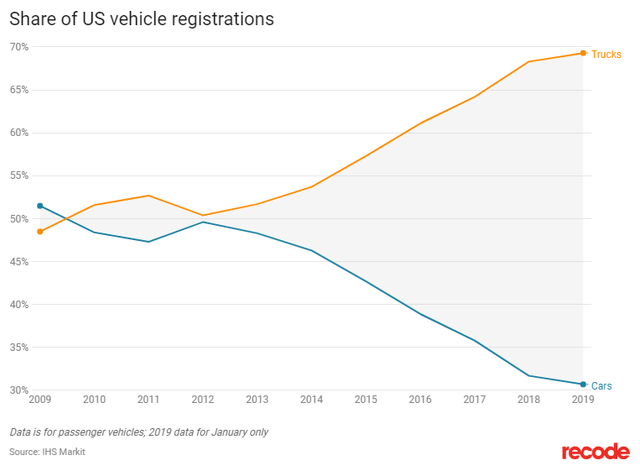Summary:
- My decade-and-a-half car and racing background was prodded by one video from the Tesla, Inc. Cybertruck release event.
- It showed trucks can have as much performance as a sports car while having the utility and ruggedness of a truck.
- The Cybertruck outperforms its EV competitors, like the Hummer EV, in terms of price and performance, too.
- Given Tesla CEO Elon Musk’s track record and the context of prior model releases, the Cybertruck is launching at the best time for a shot at success.
Roman Tiraspolsky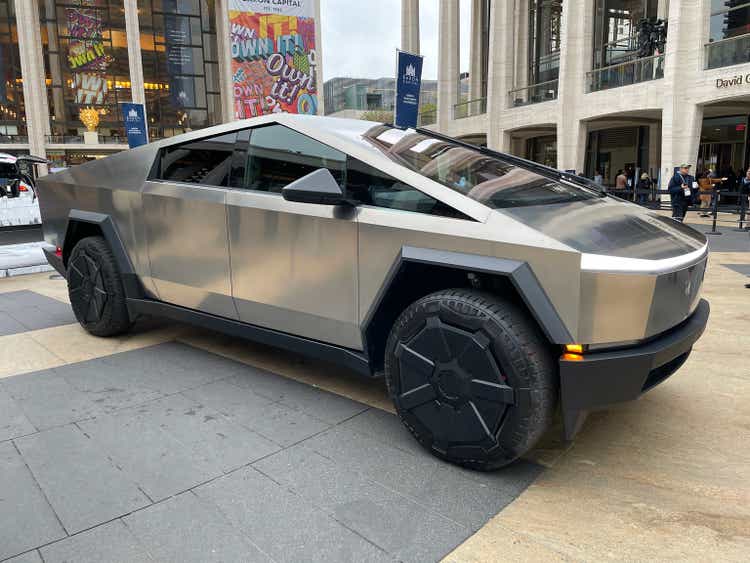
Hi, my name is Joe. You most likely haven’t read an article of mine before, even though I’ve been writing for over nine years, because I’ve never written a Tesla, Inc. (NASDAQ:TSLA) article until today. If you have read something by me, you know I write about technology, growth, and cryptocurrency assets. I’ve also never owned, traded, or done anything with Tesla stock or options. I’ve never owned a Tesla (or any electric vehicle (“EV”), for that matter) and never provided an opinion on Tesla publicly.
You’re now likely wondering what business I have publishing a Tesla article. Well, for one, I have a storied car and racing history, not just behind the wheel but under the hood (and roof, and trunk, and frame rails), and when the Cybertruck was officially released a few weeks ago, I was interested in one aspect: the performance of it. I realized while there are several internal combustion engine (“ICE”) trucks whose performance I know well and appreciate, an EV capable of beating a performance vehicle in a drag race while also towing the same hits a little differently. It was then I realized Tesla CEO Elon Musk ushered in a new era of electric vehicles and, more specifically, trucks – a vehicle able to be fun and provide utility while having a performance edge.
Let me back up a bit and start with a brief history to introduce why I wanted to write an article on a company I’ve never written about before, let alone an industry I’ve never ventured into analysis-wise.
Why Do I Care?
First, I’m a car enthusiast.
But before you think I’m just a weekend warrior and like to change my oil like the neighbor, I have over a decade-and-a-half background in high-performance street driving, instructing, fabricating race cars, and being a part of a championship race team.
This is why when I saw Tesla’s Cybertruck video racing a Porsche 911 while towing a Porsche 911, I had to stop and think, “OK, marketing or not, it still proves a point about the vehicle or, at the very least, EVs.”
My racing and car senses began to well up, and I realized I was watching a new era of vehicles come to light.
Where Those Car Senses Came From
My car and racing journey started much like my computer engineering journey: tinkering, reading (a lot of it), and learning. But it wasn’t until college that I could take it to a different level, a level where I could foster and expand it. It was here where I learned to design, fabricate, and race a vehicle.
I joined a college club known as Baja SAE to participate in the same-named worldwide competition. And just like it sounds, it’s a sanctioned SAE competition with Baja vehicles. But, before you think it’s a full-sized two-seat Baja, California-style car, this is a college engineering competition. It’s a “mini” version of the competition and vehicle you’re thinking of, as this was a single-seat, off-road, buggy-looking vehicle.
In the shop working on the race vehicle, circa 2009 (Author’s picture)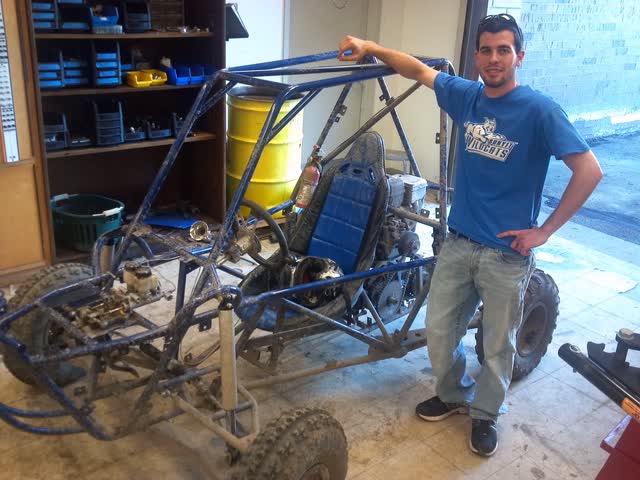
However, don’t let its size fool you. Even with the spec-required and provided 10HP (yes, 10) Briggs and Stratton motor, it can pull a Dodge RAM 2500 from a standstill, tractor-pull style. And that’s mainly due to the drive train and transmission the team decides upon to get the power to the ground.
Me taking one of the chassis out for a test run (Author’s picture)
We competed against colleges from across the U.S. and around the world, including South Korea, France, Canada, Mexico, and notable names like Rochester Institute of Technology, University of Tennessee, Virginia Tech, and Purdue University.
Me welding one of my later year frames (Author’s picture)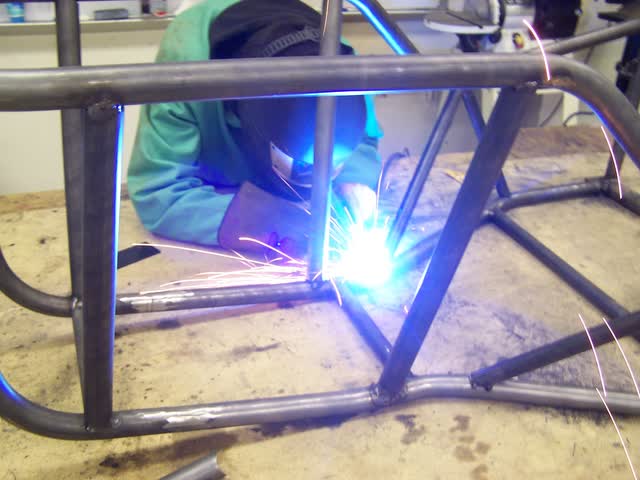
Through these experiences and competition, I learned to design frames and roll cages, MIG weld, lathe components, fabricate panels, learn braking dynamics and torque, how to race on dirt, and lead a team of college students through the ups and downs of racing with all the deadlines, reports, and fundraising challenges along the way to get us to the competition.
Alongside these dirt racing experiences in college, one of my close friends (also Baja teammate) and I ventured into asphalt road racing-style driving. Through the Audi Club of North America, and more specifically Northeast Quattro (NEQ), we were able to take our street cars to famed tracks like Watkins Glen, Lime Rock, and Pocono Raceway and learn high-performance driving skills as students, flying down straightaways as fast as 150MPH (yes, my street car didn’t have a limiter).
The front straight at Limerock in my street car (Author’s picture)
But it wasn’t until we joined the other side of the NEQ on the ice that our fun took new heights.
Yes, ice.
This was the same student-instructor setup as the road courses, but on frozen lakes in upstate New York. It was here we learned about another organization called the Adirondack Motor Enthusiast Club (AMEC). Both clubs worked closely with one another, but AMEC provided real door-to-door (but don’t touch!) racing on snow-plowed mile-long road courses on 12+ inch thick frozen lakes.
After a few years as NEQ students, we built our purpose-built street-modified race cars and started our AMEC ice racing careers.
Me on my way to my first victory in 2017 (Author’s picture)
We won races and championships over the years and enjoyed dominant performances along with the heartbreak and letdowns of broken components and failed equipment. Simultaneously, we took on the role of ice instructors and taught students how their street car handles in low friction environments using skid pads, slaloms, and the same full-sized racing course we’d use the following day for competition.
We had come full circle.
My first race wins came in back-to-back heats in 2017 (Author’s picture)
Racing isn’t easy for two guys out of a three-car home-based garage, but those moments of victory made the long nights, tired hours, and frustrating, uncooperative race cars worth it. As an owner, driver, and mechanic, you learn quite a bit about performance, advantages, and sometimes what appeared bad, perhaps was a serendipitous new car setup to win races.
How My Background Has Been Tickled By Tesla
“Joe, this is great and all; thanks for sharing, but what does this have to do with Tesla’s Cybertruck?”
I haven’t had the calling to write about Tesla or analyze its business model and finances over the years, primarily due to it not being a pure technology company in the typical sense. Still, it hit differently when I saw the Cybertruck doing things usually reserved for cars. It was the first time I saw the marketing of a truck aimed toward the performance aspect more in line with a sedan or coupe, not just the typical subjective and objective qualities like ruggedness, towing capacity, or how high it can be lifted.
Now, I didn’t give you my background to provide a grand entrance to the all-too-easy argument from authority fallacy. I gave you my past to explain why this moment in car manufacturing history was impactful enough to make me stop and think about what happened a few weeks ago in Austin, Texas.
It took that in car manufacturing for me to wish to opine about what the potential is.
Separating The Wishful From The Actual
When I see a lot of opinions flying around about what the Cybertruck is and what it isn’t, it reminds me of my days on car forums and at the track when views came from people who never put time under the hood or into vehicle dynamics or any of the skills to give them experience in those two areas.
And just like then, all kinds of people today are trying to spin this drag racing video as a marketing ploy, an unfair race, or some sort of Cybertruck open secret advantage. But even the reasonings miss the entire point of the exercise: it was towing a vehicle and won.
One car media outlet missed the ball completely:
If the Cybertruck’s electric motors couldn’t produce enough torque to outrun a 911 Carrera, I’d be very concerned.
Yeah, I’d be, too.
Except for the fact it was also towing the same model car it was racing.
And that’s the point.
An electric vehicle should handily beat almost any ICE vehicle in a drag race. And they have ever since Tesla introduced Ludicrous mode on Model S and Model X. But doing so while towing its competitor’s next production number should – and does – pull back the raw advantage, shifting the power-to-weight ratio to the sports car.
It was clearly to the 911’s advantage once the Cybertruck hooked up to the car trailer. With 845HP coming from the Cybertruck and its 6,843 curb weight, plus the 3,354-pound, 379HP 911 and a 1,700-pound aluminum trailer, the power-to-weight ratio for the Cybertruck comes in at 0.071 hp/lb, while the 911 is 0.113 hp/lb.
Higher is better – it means there’s more horsepower per pound. And the Carrera has it by 59% in this situation.
This proves torque is an underrated metric and isn’t usually touted because horsepower is the headline number and what sells cars. Torque, among a few other aspects, is why the Cybertruck could beat a sports car while towing a sports car.
And I can understand the reason for using the 911 Carrera and not a track-focused 997 GT3 or a Carrera 4: price. The GT3 is upwards of $170,000, while the current Carrera is closer to $105,000, give or take. This aligns it with what you get for the Cybertruck’s Cyberbeast near $100,000 price tag.
The combination of all the factors makes the video and drag race come together.
Porsche has cars capable of beating a Cybertruck while towing something (and without, most likely), but that’s not the point. The point is for the price – dollar-for-dollar – the performance of this truck is better than that of a similarly priced sports car.
With the Cybertruck and the videos Tesla has released, Elon Musk has combined all facets of a vehicle into one – utility, performance, and price (and green energy, if that’s a tipping point for you).
But There Are Competitors!
While some talk non-stop about the “high” price of the top-level Cybertruck – Cyberbeast – the EV competitors’ answer is more expensive and performs worse.
Take the General Motors (GM) Hummer EV as an example. It, too, is a 3-motor design, but with higher horsepower and torque (1,014HP to Cyberbeast’s 845HP). However, it’s 2,260 pounds heavier and costs $10,000 more. But the worst part is the Hummer EV gets beat in every 1/4 mile race (standing or rolling) by the Cybertruck.
So, while the Cybertruck may have less power on the spec sheet, it doesn’t need the added horsepower or torque to find the win light. Plus it costs less.
But The Financials!
“OK, wonderful, the Cybertruck is the greatest truck on earth, but it’ll kill Tesla financially.”
This is where you also have to look at the track record of Elon Musk and Tesla to provide context for what a new mass-production vehicle means. Any new product will be cash flow negative because volume production is critical to overcoming fixed overhead costs. Even ramping software, notorious for very high gross margins, puts a damper on company-wide gross margins, as ramping any product places more emphasis on the low volumes it’s selling.
But with Tesla squarely cash flow positive from its other models, it can afford to launch a new and very edgy model and take the hit in the short term until it can ramp.
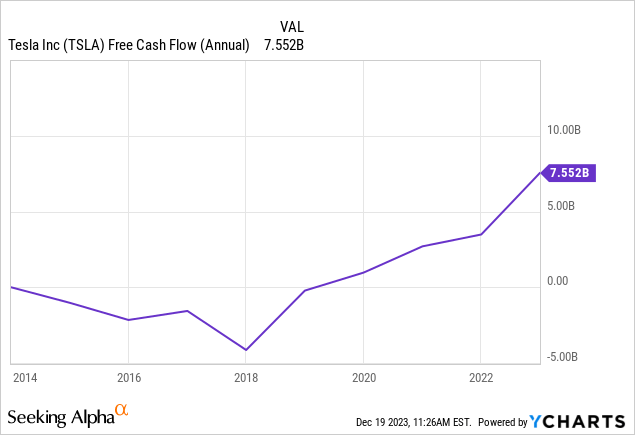
No matter your opinion of Elon Musk, he has proven he can make something profitable everyone said couldn’t be. He also has done it after what looks like “setbacks” by pricing a model much higher than promised.
In 2017, this higher-than-promised routine happened with the Model 3. Here’s a 2019 article outlining what happened just two years prior:
But Tesla originally couldn’t afford to sell [Model 3] at the promised price of $35,000, so it instead sold much more expensive souped-up versions of the Model 3. At the upper end, those cost more than twice as much as originally advertised.
…
Still, the Model 3 has been wildly popular. It had the impressive distinction of being not only the best-selling electric but also the best-selling luxury car in America last year.
Then, Model Y upped the ante in 2019 and is now competing for the top-selling car in 2023.
While numbers from various sites are all over the place in terms of Toyota and Tesla-model-specific production numbers, the fact Tesla’s Model Y is even considered in the top five of best-selling cars wasn’t even a consideration for bears when it was first released.
To discount the Cybertruck before mass production sales even set off is premature at best and discounts Elon’s track record at ramping other models to profitability. Considering trucks have taken over vehicle registrations in the U.S. by a wide margin, launching a pickup truck has the same or better odds of success as a Model Y SUV platform.
There’s Been A Tipping Point In Trucks
It comes down to not just riding the tailwinds of U.S. consumer purchasing habits when it comes to vehicles but redefining what a truck – an electric truck – is while shaping the market itself. Elon has produced a truck capable of competing with sports cars in drag races, making it durable enough to take bullets while coming in at a price – though high to most – cheaper than competitors providing less flair.
I haven’t had a reason to say anything about Tesla until now, and it’s because while Tesla has outperformed expectations in terms of vehicle sales and profitability over the years (as its stock can attest), there hasn’t been anything too striking to mention. But when I saw the video of its truck’s competitive abilities on the drag strip, I realized Elon realized trucks don’t have to be just about hauling and being big; they can perform under the usual car definition.
Only time will tell how successful the Cybertruck is, when it’ll hit profitability, and when Elon can start cutting the price. But the writing is on the wall for Tesla, Inc. success, given his track record, this new product’s capabilities, and the company’s ability to stir up quite a conversation with just one video.
Analyst’s Disclosure: I/we have no stock, option or similar derivative position in any of the companies mentioned, and no plans to initiate any such positions within the next 72 hours. I wrote this article myself, and it expresses my own opinions. I am not receiving compensation for it (other than from Seeking Alpha). I have no business relationship with any company whose stock is mentioned in this article.
Seeking Alpha’s Disclosure: Past performance is no guarantee of future results. No recommendation or advice is being given as to whether any investment is suitable for a particular investor. Any views or opinions expressed above may not reflect those of Seeking Alpha as a whole. Seeking Alpha is not a licensed securities dealer, broker or US investment adviser or investment bank. Our analysts are third party authors that include both professional investors and individual investors who may not be licensed or certified by any institute or regulatory body.
Join The Top AI And Tech Investing Group
Do two things to further your tech portfolio. First, click the ‘Follow’ button below next to my name and then sign up to be a free member of my investing group Tech Cache. You’ll get more free content from me, no paywall, and no credit card. If you want insights about tech stocks and assets, similar to the article you just read, step up to being a paid subscriber with a two-week free trial and read my exclusive content immediately.

